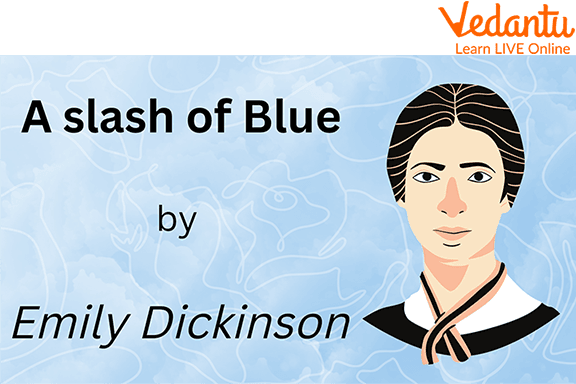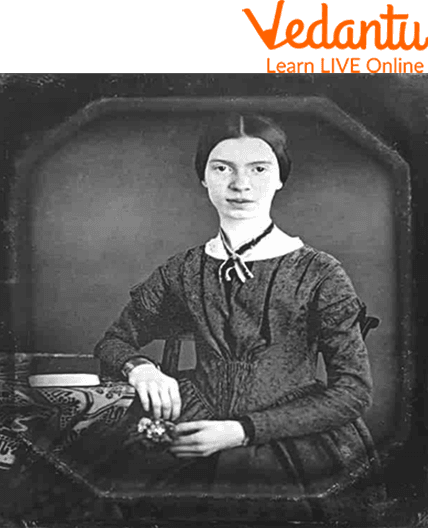Overview of the Blue Colour Poem
Even while Dickinson doesn't discuss the Civil War specifically in her poems, there are occasional references to it. This one is one. When the Civil War started, the poem was composed. Blue and Grey were the official colours of the Union and Confederate armies, respectively.
The best way to teach colours is through enjoyable real-world activities. We will learn about the concept of colours used in poetry through this blue colour poem for kindergarten. Let’s learn about the different shades of the sky that the poet runs us through.
A Slash of Blue Poem
A slash of Blue! A sweep of Grey!
Some scarlet patches – are on the way –
Compose an evening sky –
A little purple – slipped between –
Some Ruby Trousers – hurried on –
A Wave of Gold – A Bank of Day –
This just makes out the Morning Sky!

A Slash of Blue by Emily Dickinson
The Theme of the Poem
Each stanza's last rhymes, "sky" and "Sky," appropriately combine with the rhymes "Gray," "way," and "Day." Echoing words like "slipped between" and "hurried on" add to the poetic coherence. The initial and sixth sentences, however, may be the most important ones. We have prepositional phrases for "A slash," "A sweep," "A wave," and "A bank." The majority of these expressions use colour. This poem contains a lot of hues, including blue, grey, purple, ruby, scarlet, and as well as gold.
About the Author
The poet from America, Emily Elizabeth Dickinson lived from December 10, 1830, to May 15, 1886. Although she was not well-known when she was alive, she is now acknowledged to be one of the most significant individuals in American poetry.
Dickinson, born into a rich family, also had a well-known family with connections to the neighbourhood in Amherst, Massachusetts. She spent her early years studying at Amherst Academy for over seven years, then went to Mount Holyoke women's College for a short time before returning to the Amherst home of her family.
There is evidence that Dickinson spent a significant portion of her life alone. She developed a preference for wearing white attire and was well known for being reluctant to receive visitors or, later in her life, even leave the bedroom. Locals thought she was odd. Dickinson never wed, and the majority of her relationships with others relied solely on letter writing.

Emily Elizabeth Dickinson
The Literary Meaning of the Poem
This is one of those poems about the colour blue that rhymes. We start with a straightforward 2 different depictions of sunrise and dusk.
The growing greyness in contrast to the "slash of Blue" is the key aspect of the straightforward "evening sky" shown in the opening line. Instead of taking centre stage like the reds as well as purples in some of the other, more opulent sunset poetry, the "scarlet patches" here serve as accents on the larger picture. They may, however, be a sign of more striking colours to come because they are still "on the way."
The "Ruby Trousers" emerge fast; they have been "hurried on" as if Morning were running a little behind and have been dressed in a few bright pieces. This is where Dickinson's playful creativity with dawn really shines. The "Bank of Day" complements the "Wave of Gold" as the sun comes up over the horizon. The entire morning's gold is stashed for usage throughout the day. The opening verse is composed as though reading "Evening Sky, Amherst, 1861" from a photograph or painting. One interpretation of the second stanza's final line, "This merely makes out all the Morning Sky," is as a depiction of an art piece of dawn at a gallery.

A Slash of Blue in the Sky
Summary
The poem is famous for its motion: Grey sweeps; Blue is slashed on. Moving from across the sky are the crimson spots. In the evenings, the purple is quickly put on, the pants are thrown on, and the gold is a wave that is moving. However, in each stanza, the motion is frozen onto the page as though Dickinson had recorded it all on her phone.
In this article, we learnt about the author of the blue colour poem Emily Dickinson. We read the blue colour poem for kindergarten. The poem was one of those poems about blue colour that rhymes. We hope you enjoyed reading this amazing poem, in case of any other doubts, feel free to ask in the comments.


FAQs on Blue Colour Poem
1. What is the best-known passage by Emily Dickinson?
Hope is a feathered object that resides in the soul and sings melodies without using words. It never stops.
2. What is the best-known poem by Emily Dickinson?
One of Dickinson's most well-known poems is unquestionable "Because I could not halt for Death." Death is frequently employed as a symbol or metaphor in her works, but this one stands head and shoulders above the rest. "Death" seems to be a living entity.
3. What kind of personality did Emily Dickinson have?
A poet from the 19th century, Emily Dickinson was well-known for her intense introversion and dismal perspective.





